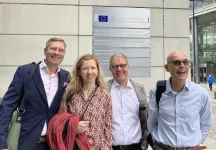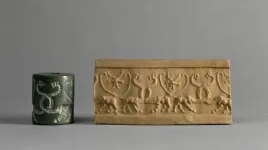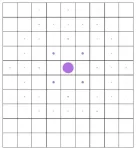(Press-News.org) Iliana Ivanova, Commissioner for Innovation, Research, Culture, Education and Youth, said: “Innovation thrives on collaboration, especially when tackling the pressing scientific challenges of our time. The ERC Synergy Grants work with Horizon Europe funding to connect brilliant minds across borders and disciplines, enabling them to push the frontiers of knowledge together. I am particularly delighted to see researchers from countries with historically fewer ERC grants among the awardees, reflecting our mission to foster scientific excellence across Europe.”
President of the European Research Council, Prof. Maria Leptin, said: “It is so inspiring to see how the Synergy Grants bring together remarkable researchers from many disciplines, countries and even continents, united by their ambition to tackle difficult research questions. Many of the teams include a researcher based outside Europe, which shows the global and open character of these grants. Congratulations to all the winners – I much look forward to following their progress as they push our boundaries of knowledge.”
Projects selected for funding
Can we make concrete infrastructure both eco-efficient and durable? What is the nitrogen cycle of our oceans and its impact on the climate? Can digital technology help bring communities together? These are just some examples of issues the new winners in this round of Synergy Grants will explore.
.
Facts & figures
Applicants submitted 548 proposals in this call. The 57 winning projects involve 201 researchers who will carry out their projects at 184 universities and research centres in 24 countries across Europe and beyond: Germany (with 34 projects), the UK (18), France (13), the US (12), Spain (11) and Netherlands (10) are hosting the highest number of projects. Six projects involve researchers based in Czechia (2 projects), Greece (1), Hungary (1), Poland (1) and Portugal (1) - countries that have so far hosted fewer ERC grants.
Twenty-two of the groups include one researcher based outside Europe: in the US, Switzerland, Australia and - for the first time – the Republic of Korea. The international aspect of this grant scheme helps to open top European research to the best scientific talent globally, creating further synergies.
Nearly 32% of the researchers who are part of the winning projects are women, the highest proportion since the scheme began. This marks a notable increase compared to previous years, with 18.5% in 2023 and 22% in 2022. Additionally, six research teams are composed entirely of female researchers.
See the full list of winners.
About the ERC
The ERC, set up by the European Union in 2007, is the premier European funding organisation for excellent frontier research. It funds creative researchers of any nationality and age, to run projects based across Europe. The ERC offers four core grant schemes: Starting Grants, Consolidator Grants, Advanced Grants and Synergy Grants. With its additional Proof of Concept Grant scheme, the ERC helps grantees to bridge the gap between their pioneering research and early phases of its commercialisation. The ERC is led by an independent governing body, the Scientific Council. Professor Maria Leptin has been the President of the ERC since November 2021. The overall ERC budget from 2021 to 2027 is more than €16 billion, as part of the Horizon Europe programme, under the responsibility of European Commissioner for Innovation, Research, Culture, Education and Youth, Iliana Ivanova.
ERC press contacts
Kerstin Dörflinger
Press and Communication officer
Phone: +32 (0)2 296 50 59
ERC-PRESS@ec.europa.eu
END
ERC Synergy Grants for 57 teams tackling major scientific challenges
2024-11-05
ELSE PRESS RELEASES FROM THIS DATE:
Nordic research team receives €13 million to explore medieval book culture
2024-11-05
The CODICUM project brings together experts in history, literature, and bio-codicology from four Nordic universities to explore medieval knowledge networks. This groundbreaking study combines traditional humanities approaches with cutting-edge biomolecular analysis of fragments from medieval books, written on animal skin.
How book culture shaped medieval Europe
The project will investigate approximately 50,000 medieval Latin book fragments preserved in Nordic collections—one of Europe’s largest archives of medieval book culture.
"These fragments represent an extraordinary treasure trove that can transform our understanding ...
The origin of writing in Mesopotamia is tied to designs engraved on ancient cylinder seals
2024-11-05
The origins of writing in Mesopotamia lie in the images imprinted by ancient cylinder seals on clay tablets and other artifacts. A research group from the University of Bologna has identified a series of correlations between the designs engraved on these cylinders, dating back around six thousand years, and some of the signs in the proto-cuneiform script that emerged in the city of Uruk, located in what is now southern Iraq, around 3000 BCE.
The study—published in Antiquity—opens new perspectives on ...
Explaining science through dance
2024-11-05
Science can be difficult to explain to the public. In fact, any subfield of science can be difficult to explain to another scientist who studies in a different area. Explaining a theoretical science concept to high school students requires a new way of thinking altogether.
This is precisely what researchers at the University of California San Diego did when they orchestrated a dance with high school students at Orange Glen High School in Escondido as a way to explain topological insulators.
The experiment, led by former graduate student Matthew Du and UC San Diego Associate Professor of Chemistry and Biochemistry Joel Yuen-Zhou, was published in Science Advances.
“I ...
Pioneering neuroendocrinologist's century of discovery launches major scientific tribute series
2024-11-05
Tucson, Arizona, 5 November 2024 – Brain Medicine has launched an ambitious Festschrift series with the first of more than ten planned articles celebrating Dr. Seymour Reichlin's centennial year and his transformative impact on neuroendocrinology. The opening editorial, chronicling his revolutionary insights into brain-hormone interactions, inaugurates what promises to be one of the most comprehensive tributes in the field's history.
“One could be both a physician caring for patients and a scientific investigator,” reflects Dr. Reichlin, whose work spanning nearly 80 years has fundamentally reshaped our understanding of how ...
Gendered bilingualism in post-colonial Korea
2024-11-05
In the 1960s, Japanese books became immensely popular in South Korea. Interestingly, Korean newspapers often wrote about this trend as if mainly women were interested in learning Japanese.
Osaka Metropolitan University Associate Professor Jinsuk Yang examined South Korean newspaper articles and other historical documents from the 1960s and 1970s to understand why Japanese language learning was often described as something women did, even though men were also learning Japanese. Additionally, Professor Yang studied how women’s ability to speak Japanese affected ...
Structural safety monitoring of buildings with color variations
2024-11-05
As buildings age, the demand for effective monitoring of their structural integrity has grown significantly. A breakthrough in nano-optical sensor technology now enables precise, real-time measurement of structural deformation and stability. This innovation promises to reshape the field of structural diagnostics, offering a cost-effective, time-efficient solution that reduces the need for specialized expertise traditionally required in this area.
Led by Dr. Jae Sung Yoon, Principal Researcher at the Nano-lithography & Manufacturing Research Center within the Nano-convergence ...
Bio-based fibers could pose greater threat to the environment than conventional plastics
2024-11-05
Bio-based materials may pose a greater health risk to some of the planet’s most important species than the conventional plastics they are designed to replace, a new study has shown.
Such materials are increasingly being advocated as environmentally friendly alternatives to plastics, and used in textiles and products including clothing, wet wipes and period products.
However, microfibres of the materials are emitted into the environment through the laundry cycle, the application of sewage sludge as fertilisers, or the simple wear and tear of textile products.
Despite increasing quantities of bio-based products being produced and sold all over the world, there has been ...
Bacteria breakthrough could accelerate mosquito control schemes
2024-11-05
Mosquito larvae grow faster if they’re exposed to particular bacteria, according to a new study that could help global health programmes.
Aedes aegypti mosquitoes spread illnesses including dengue, yellow fever and Zika.
Anti-disease programmes breed and release non-biting male mosquitoes that are either sterile or prevent transmission of diseases.
These mass release programmes can be substantially more effective than the widespread spraying of insecticides, as these insects have developed resistance to many commonly employed chemicals.
The new study, by ...
Argonne to help drive AI revolution in astronomy with new institute led by Northwestern University
2024-11-04
The U.S. National Science Foundation and Simons Foundation have selected a group of institutions, including Argonne, to receive funding to establish an AI and astronomy institute called the NSF-Simons AI Institute for the Sky (SkAI).
Part of a groundbreaking effort to harness artificial intelligence (AI) to unlock the mysteries of the cosmos, the U.S. Department of Energy’s (DOE) Argonne National Laboratory is a key collaborator in the newly launched NSF-Simons AI Institute ...
Medicaid funding for addiction treatment hasn’t curbed overdose deaths
2024-11-04
For generations, the federal government has largely refrained from paying for mental health and substance use treatment in large residential facilities.
That changed in 2015 when, in response to increasing overdose deaths nationwide from illicit drugs, the federal government allowed states to waive a longstanding prohibition against using federal Medicaid funding for services in so-called institutions of mental diseases. In turn, states were required to improve their addiction care with an emphasis on increasing treatment with medications.
Yet a new study by researchers at Oregon Health & Science University finds no overall ...






